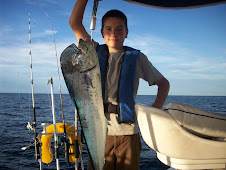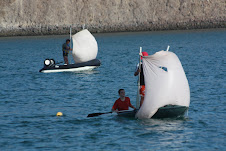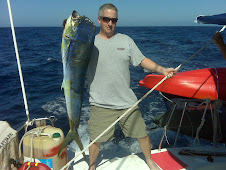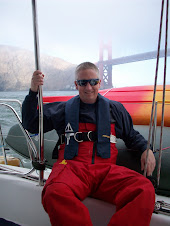 (We are currently still in La Paz waiting for a resolution to our sail drive issue, but we found this beach before our breakdown.)
(We are currently still in La Paz waiting for a resolution to our sail drive issue, but we found this beach before our breakdown.) One of Jack's and my favorite activities is beachcombing. Patrick loves it too because it means he gets the boat all to himself while we beachcomb. Jack looks for fishing lures (it's amazing how many rapalas he finds in good shape) and I look for shells.
 Since this is our third season in the Sea, our goal is to seek out the "unknown anchorage." We're going to try to be more like our friends on Eyoni who are always heading off the beaten path. We've already seen many of the no-brainer anchorages that are well known, well-written about and often crowded. Anyone looking at a map could figure out that they would provide good shelter. This time we are consulting the old guide books and Google Earth to see if any little indent looks promising for a good night's sleep and a new experience. Since they aren't the deepest of coves, you have to be a little more careful of your weather conditions and always post a "rock watch" to make sure there aren't any free-standing obstacles or reefs in the anchorage.
Since this is our third season in the Sea, our goal is to seek out the "unknown anchorage." We're going to try to be more like our friends on Eyoni who are always heading off the beaten path. We've already seen many of the no-brainer anchorages that are well known, well-written about and often crowded. Anyone looking at a map could figure out that they would provide good shelter. This time we are consulting the old guide books and Google Earth to see if any little indent looks promising for a good night's sleep and a new experience. Since they aren't the deepest of coves, you have to be a little more careful of your weather conditions and always post a "rock watch" to make sure there aren't any free-standing obstacles or reefs in the anchorage.There are two advantages the unknown anchorage offers - no neighbors and less-walked beaches. In this lower section of the Baja, we didn't think we would find anything very interesting since there are so many cruisers in this area right now. After all, this is the "cruising season" of the Sea of Cortez. The area is crawling with cruisers and the popular anchorages have up to 18 boats in them. Most everyone is finished on the mainland coast for the winter and they come here for a few months before packing up the boat and leaving it in a marina before the hurricane season. By June, the part-timer cruisers will be back home, leaving the Sea to all the crazy people willing to brave the heat and hurricanes.
So, it didn't seem possible that we would find a beach that someone hadn't walked just that morning. Oh, but we did! We went to a little indent on an island that we couldn't find mentioned in any of the cruising guides we have on board. Our reward was finding a beach that had more amazing shells than I have ever seen on any other beach. One type of shell (the one with the triangular markings) I have never found any place else! Most beaches offer up one or two shells in good shape, but usually sun bleached, their deep colors often faded to cream with faint markings. On this beach I found a hatful of beautiful shells with deep colors, and shiny finishes. It was amazing. I felt like a kid on an Easter Egg hunt - one beautiful treasure after another.
The pictures show a close up of the shells with the triangular markings (I don't have a shell identification book so I don't know the names). All of the shells on the blue cloth are the ones that I found on our Secret Beach in just an hour of looking.
















My Dear Laura...
ReplyDeleteThe genus is OLIVA... or commonly called an olive shell. The ones you found are TENT OLIVES forming the little teepees (7 letter Scrabble word there). We have found one ginormous one... ever. What luck for you! Your collection is gorgeous!
Meri
s/v Hotspur
Hi Meri!
ReplyDeleteI was thinking of you and Steff when I wrote this blog! I knew you would know the names. (I need to get one of those identification books.) I know I said it's a secret beach, but that doesn't hold for friends. I'll be happy to share the GPS location with you.
Laura
Laura- these are stunning! And seriously, I was looking for a tent olive the WHOLE TIME we were in MX! I only found one faded one... those are stunning! Excellent finds! Here's to secret anchorages. :-)
ReplyDeleteI was thinking that they looked much more like conidae conus textile shells:
ReplyDeletehttp://www.conchparadise.com/shell-detail.php?knum=100017
Deb
S/V ??? (no name yet)
www.theretirementproject.blogspot.com
The long thin shells to the upper right are
ReplyDeleteTerebra subulata. On the left edge the mahogany coloured shells are Conus Vexillium.
All live cone shells can be very dangerous, shooting a very toxic dart as much as 3 feet in air and a foot or so in the water. Take care if you collect those.
Great blog you have, thank you :-)
Paige